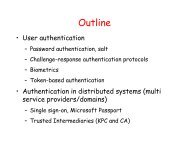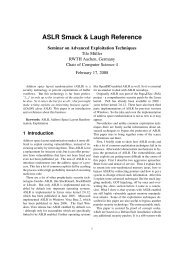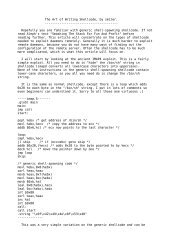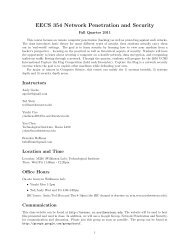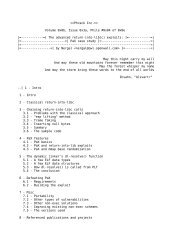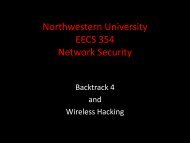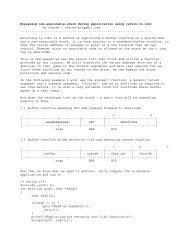Fixing Races for Fun and Profit: How to abuse atime - University of ...
Fixing Races for Fun and Profit: How to abuse atime - University of ...
Fixing Races for Fun and Profit: How to abuse atime - University of ...
Create successful ePaper yourself
Turn your PDF publications into a flip-book with our unique Google optimized e-Paper software.
<strong>of</strong> file system operations that use lexically identical arguments.<br />
Because their <strong>to</strong>ol per<strong>for</strong>ms no data flow analysis,<br />
it may fail <strong>to</strong> report some real vulnerabilities. Chen<br />
et al. used s<strong>of</strong>tware model checking <strong>to</strong> check temporal<br />
safety properties in eight common Unix applications [3].<br />
Their <strong>to</strong>ol, MOPS, is able <strong>to</strong> detect stat(2)/open(2) races.<br />
Later work with MOPS by Schwarz et al. checked all <strong>of</strong><br />
Red Hat 9 <strong>and</strong> found 41 filesystem TOCTTOU bugs [10].<br />
MOPS has similar limitations <strong>to</strong> Bishop <strong>and</strong> Dilger’s <strong>to</strong>ol<br />
because it also doesn’t per<strong>for</strong>m data flow analysis.<br />
Static analysis techniques may generate many false<br />
positives, requiring the developer <strong>to</strong> sift through numerous<br />
warnings <strong>to</strong> find the actual bugs. Dynamic techniques<br />
aim <strong>to</strong> reduce the number <strong>of</strong> false positives by<br />
observing runtime program behavior <strong>and</strong> looking <strong>for</strong><br />
TOCTTOU race conditions. Tsyrklevich <strong>and</strong> Yee detected<br />
races by looking <strong>for</strong> “pseudo-transactions”, i.e.<br />
pairs <strong>of</strong> system calls that are prone <strong>to</strong> TOCTTOU file<br />
race vulnerabilities [12]. Upon detecting a race in a running<br />
system, their <strong>to</strong>ol asks the user <strong>for</strong> a course <strong>of</strong> action.<br />
Ko <strong>and</strong> Redmond used a similar approach <strong>to</strong> look<br />
<strong>for</strong> dangerous sequences <strong>of</strong> system calls [7]. They wrote<br />
a kernel extension that looks <strong>for</strong> interfering system calls,<br />
i.e. system calls that changes the outcome <strong>of</strong> another<br />
group <strong>of</strong> system calls. For example, their scheme would<br />
detect our attack because the attacker’s unlink(2) calls interfere<br />
with the victim’s calls <strong>to</strong> open(2) <strong>and</strong> access(2).<br />
Cowan et al developed RaceGuard, a kernel enhancement<br />
that prevents temporary file creation race conditions<br />
by detecting changes <strong>to</strong> the file system between<br />
calls <strong>to</strong> stat(2) <strong>and</strong> open(2). Related <strong>to</strong> Tsyrklevich <strong>and</strong><br />
Yee’s pseudo-transaction notion, the QuickSilver operating<br />
system adds support <strong>for</strong> filesystem transactions [9].<br />
A process could prevent TOCTTOU races by enclosing<br />
dependent system calls in one transaction. Mazières <strong>and</strong><br />
Kaashoek give principles <strong>for</strong> designing an operating system<br />
<strong>to</strong> avoid TOCTTOU bugs [5]. They note that an attacker<br />
can create many files in a direc<strong>to</strong>ry so that name<br />
resolution slows down <strong>and</strong> hence easily win TOCTTOU<br />
file races. Their solution encompasses a richer OS interface<br />
<strong>to</strong> enable finer grain access controls <strong>and</strong> greater<br />
control over name resolution.<br />
10 Conclusion<br />
We described a practical attack on the k-Race algorithm,<br />
developed a r<strong>and</strong>omized version <strong>of</strong> k-Race, <strong>and</strong> broke<br />
that scheme, <strong>to</strong>o. The latter attack shows that our system<br />
call distinguishers are a powerful attack <strong>to</strong>ol <strong>and</strong> that our<br />
attack is insensitive <strong>to</strong> the exact sequence <strong>of</strong> system calls<br />
per<strong>for</strong>med by the victim. We there<strong>for</strong>e reaffirm the conventional<br />
wisdom that access(2) should never be used in<br />
secure programs. The <strong>to</strong>ols we created as part <strong>of</strong> this<br />
attack — mazes, system call synchronizers, <strong>and</strong> system<br />
call distinguishers — are applicable <strong>to</strong> a wide variety <strong>of</strong><br />
Unix filesystem races. We discussed several alternative<br />
solutions <strong>to</strong> access(2)/open(2) races that <strong>of</strong>fer deterministic<br />
security guarantees.<br />
Availability<br />
The source code <strong>for</strong> our k-Race implementation <strong>and</strong> attack<br />
s<strong>of</strong>tware is available at http://nikita.ca/<br />
research/races.tar.gz.<br />
Acknowledgements<br />
We would like <strong>to</strong> thank David Molnar <strong>and</strong> the anonymous<br />
reviewers <strong>for</strong> their insightful comments <strong>and</strong> our<br />
shepherd, Eu-Jin Goh, <strong>for</strong> his help in preparing the final<br />
version <strong>of</strong> this paper. This work was supported in part by<br />
the NSF under grants CCR-0093337 <strong>and</strong> CCF-0430585<br />
<strong>and</strong> by the US Postal Service.<br />
References<br />
[1] Matt Bishop <strong>and</strong> Michael Dilger. Checking <strong>for</strong> race<br />
conditions in file accesses. Computing Systems,<br />
9(2):131–152, Spring 1996.<br />
[2] Hao Chen, Drew Dean, <strong>and</strong> David Wagner. Setuid<br />
demystified. In Proceedings <strong>of</strong> the 11th Usenix Security<br />
Symposium, pages 171–190, August 2002.<br />
[3] Hao Chen, Drew Dean, <strong>and</strong> David Wagner. Model<br />
checking one million lines <strong>of</strong> C code. In Proceedings<br />
<strong>of</strong> the 11th Annual Network <strong>and</strong> Distributed<br />
System Security Symposium (NDSS), pages 171–<br />
185, February 2004.<br />
[4] Drew Dean <strong>and</strong> Alan Hu. <strong>Fixing</strong> races <strong>for</strong> fun <strong>and</strong><br />
pr<strong>of</strong>it: <strong>How</strong> <strong>to</strong> use access(2). In Proceedings <strong>of</strong><br />
13th Usenix Security Symposium, pages 195 – 206,<br />
August 2004.<br />
[5] David Mazières <strong>and</strong> M. Frans Kaashoek. Secure<br />
applications need flexible operating systems. In<br />
Proceedings <strong>of</strong> the 6th Workshop on Hot Topics in<br />
Operating Systems (HotOS-VI), pages 56–61, 1997.<br />
[6] Norm Hardy. The confused deputy: (or why capabilities<br />
might have been invented). ACM SIGOPS<br />
Operating Systems Review, 22(4):36–38, Oc<strong>to</strong>ber<br />
1988.<br />
[7] Calvin Ko <strong>and</strong> Timothy Redmond. Noninterference<br />
<strong>and</strong> intrusion detection. In Proceedings <strong>of</strong> the 2002<br />
IEEE Symposium on Security <strong>and</strong> Privacy, pages<br />
177–187, May 2002.




